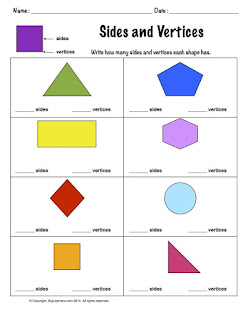
A first grade class I worked in this week learned had to circle the exact shapes in the format displayed in the "Build and Repeat" section to the "Combine. Which new shape can you make? Circle it." This is a general education classroom setting with 22 students and all were present.
For the first one the students had to look at how the cone and rectangular prism was displayed on the left and find what picture on the right demonstrated the same as the left. The students that picked the picture with the cones on top of the two rectangular prisms were told to observe the images again and then they realized that the image with one cone on top of each rectangular prism was the correct answer. Some children realized independently of one another that the image of the correct answer was flipped opposite of each other but looked exactly like the "Build and Repeat side.
The second line is a cone on top of a cube and the all but six of the students got the answer correct. Once they were reminded that the shapes had to be the same, four of the six got the correct answer, which is the first set with cones on top of the cubes. With more attention and support the other two got them correct also.
Like the first problem this last problem made the children unsure of their answers. The first problem was demonstrated on the smart board and 20 of the 22 students got it correct. These were the same students that missed the correct answer for the second one. These students were then given card board cube and rectangle prism blocks to work with. The manipulatives served as a good concrete tool to illustrate the correct answer which is the vertical set of rectangular prisms with two cubes on top of them.
I can see how the children that struggled got confused. This lesson encouraged the children to not only write the correct answer, but explain how did they know if the answer was right or wrong. http://www.corestandards.org/Math/Content/1/MD/

Looking at the problem and working with kids I automatically knew why students mistaken the shapes. In all honestly I believe its about second guessing. In first grade students do not like to make mistakes or be embarrassed in front of the class. If the teacher would have placed the new shapes on separate sheets of paper the students would have been able to tell the new shape they can make. On the other hand, for students who do need the extra help maybe having the shapes in front of them so they can physically make it will help. Involving the students will be helpful because they can see where they went wrong and better explain themselves because it is no longer a drawing. I enjoyed this problem and hope to see more.
ReplyDeleteGreat Post Shelia
Thank You, Sheila.
DeleteHi Veronica, one thing I have learned in this class in the power and magic of manipulatives. I was not taught in a math class that use manipulatives, but I've learned how important they are to learners of all ages. I work mainly with 6th through 8th grade students and I'm trying to find manipulatives that students can use at that level. I feel like as students progress through mathematics, these great supports and strategies are not available to them. Like you observed in the math class, not everyone may need the manipulative, but I like the idea of having something available for those students who do need that extra help. I also like the way manipulates can progress with a student as their confidence grows. They can advance from the physical blocks and cubes to pictures on their worksheets. Nice work.
ReplyDeleteThank you, Jill. I agree. Manipulative can be a big help to students that may need extra support in math.
DeleteVeronica,
ReplyDeleteThis was a great and informative blog post! I have learned in my years of working with young students, that using manipulative’s are extremely important for their and understanding. Being able to feel, see, and touch physical objects really can give students a deeper understanding of how to complete many different tasks. I think about myself, just like yourself, and how this worksheet would seem confusing. Sometimes these things are just too concrete for certain students. I work with k-1-2 and I could say only two students are able to complete tasks with concrete information and evidence. The other six students need to use manipulative’s in order for them to grasp the concepts. Thank you for this post and showing us how easy it is for students to become confused and how we can help them in situations like this one. Good work Veronica! Looking forward to reading your next blog.
Thank you, Nicole.
Delete